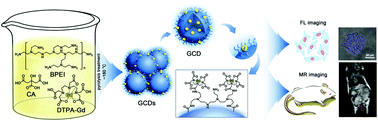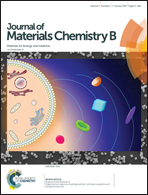One-pot synthesis of gadolinium-doped carbon quantum dots for high-performance multimodal bioimaging†
Abstract
In this study, an efficient and mild approach is reported for the facile synthesis of a carbon quantum dot (CQD)-based dual-modal fluorescence (FL)/magnetic resonance (MR) imaging probe by doping Gd(III) into CQDs through a one-pot pyrolysis process at low temperature. The as-prepared Gd-encapsulated CQDs (GCDs), which have an average diameter of ∼15 nm, are highly water-soluble. The GCDs are observed to have a high MR response with a longitudinal relaxation of 57.42 mM−1 s−1 and a strong fluorescence brightness with an absolute quantum yield of 40% while containing only 1.0% (w/w) of Gd3+ content. Stemming from the minimum Gd-doping and the inert carbon coating, GCDs exhibit excellent biocompatibility and blood compatibility. Dual-modality bioimaging applications of GCDs are successfully demonstrated by the use of HeLa cells and mice as models, revealing their great potential in fundamental biomedical research studies and even clinical fields such as fluorescence-guided surgery and dual-modal FL/MR imaging of blood vessels.

- This article is part of the themed collection: JMC B Editor’s choice web collection: ‘‘seeing the unseen updated: advances in bioimaging’’

 Please wait while we load your content...
Please wait while we load your content...